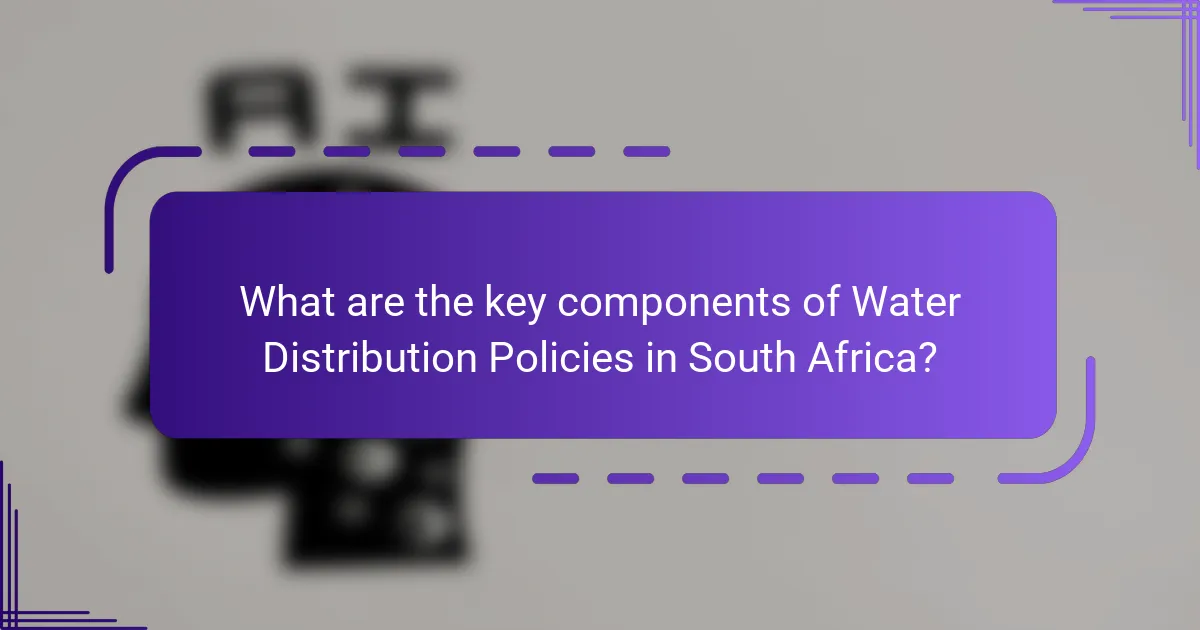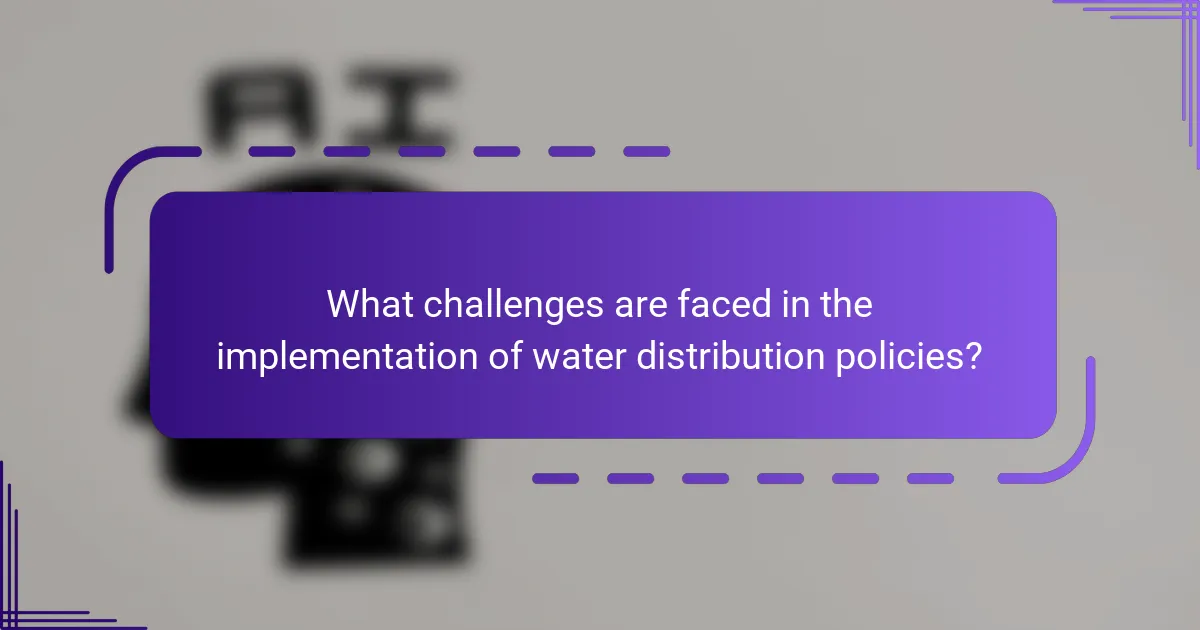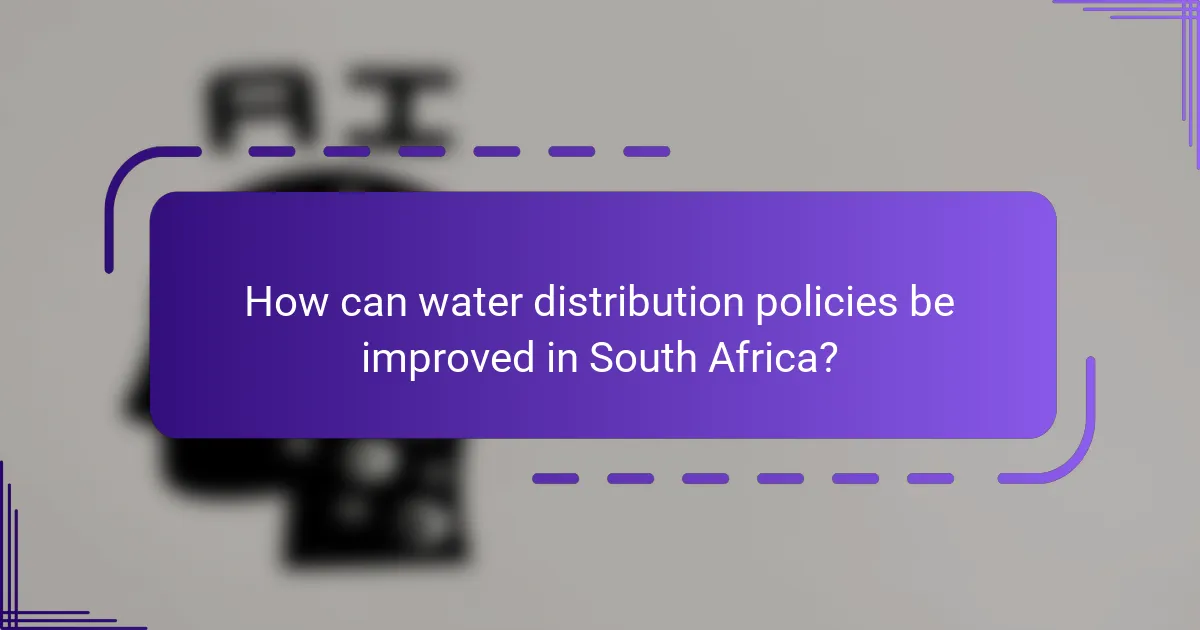Water Distribution Policies in South Africa encompass regulatory frameworks, institutional arrangements, and infrastructure development crucial for equitable access to water and sustainable resource management. The regulatory frameworks provide legal guidelines, while institutional arrangements clarify stakeholder roles, including government and private entities. Infrastructure development focuses on constructing and maintaining water supply systems, addressing challenges such as inadequate infrastructure, funding shortages, and regulatory complexities. To enhance these policies, improvements in regulations, stakeholder engagement, technology implementation, and public awareness are essential for effective water management and service delivery.

What are the key components of Water Distribution Policies in South Africa?
The key components of Water Distribution Policies in South Africa include regulatory frameworks, institutional arrangements, and infrastructure development. Regulatory frameworks establish the legal and policy guidelines for water distribution. Institutional arrangements define the roles and responsibilities of various stakeholders, including government agencies and private entities. Infrastructure development focuses on the construction and maintenance of water supply systems. These components aim to ensure equitable access to water and sustainable management of water resources. According to the National Water Act of 1998, these policies seek to promote efficient and effective water use.
How do regulatory frameworks shape water distribution in South Africa?
Regulatory frameworks shape water distribution in South Africa by establishing guidelines for resource management. These frameworks include the National Water Act of 1998 and the Water Services Act of 1997. The National Water Act provides a legal framework for the equitable allocation and sustainable use of water resources. It emphasizes the need for integrated water resource management. The Water Services Act focuses on ensuring access to water services for all citizens.
These laws require local governments to develop water distribution plans. They also mandate community involvement in water management decisions. Compliance with these frameworks is monitored by the Department of Water and Sanitation. Non-compliance can result in penalties or loss of licenses.
The frameworks aim to address historical inequalities in water access. They promote the protection of water quality and ecosystems. Overall, regulatory frameworks are essential for guiding water distribution practices in South Africa.
What laws and regulations govern water distribution policies?
The laws and regulations governing water distribution policies in South Africa include the National Water Act of 1998. This act provides a framework for the management, use, and distribution of water resources. It emphasizes the equitable allocation of water and the protection of water quality. The Water Services Act of 1997 also plays a critical role. It focuses on the provision of water services to communities and the responsibilities of water service authorities. Additionally, the Constitution of South Africa guarantees the right to access sufficient water. These laws collectively ensure sustainable and fair water distribution in the country.
How is compliance with these regulations monitored?
Compliance with these regulations is monitored through regular inspections and audits. Regulatory bodies, such as the Department of Water and Sanitation, conduct these evaluations. They assess adherence to water quality standards and distribution practices. Reports from these inspections are documented and analyzed. Non-compliance may result in penalties or corrective actions. Data on compliance rates is collected and published annually. This ensures transparency and accountability in water distribution. Monitoring also involves stakeholder feedback and community reporting mechanisms.
What are the roles of various stakeholders in water distribution?
Various stakeholders play crucial roles in water distribution. Government entities regulate and oversee water distribution policies. They establish legal frameworks and ensure compliance with water quality standards. Water utility companies manage the infrastructure for delivering water to consumers. They are responsible for maintenance and service delivery. Local communities participate in decision-making processes. Their input helps address specific needs and concerns regarding water access. Non-governmental organizations advocate for equitable water distribution. They raise awareness of water-related issues and support marginalized communities. Private sector partners may invest in water infrastructure projects. Their involvement can enhance efficiency and innovation in water distribution systems.
Who are the primary stakeholders involved in water distribution policies?
The primary stakeholders involved in water distribution policies include government agencies, local municipalities, water service providers, and community organizations. Government agencies, such as the Department of Water and Sanitation, set regulations and guidelines. Local municipalities are responsible for implementing water distribution at the community level. Water service providers, both public and private, deliver water services to consumers. Community organizations represent the interests of residents and advocate for equitable access to water. These stakeholders collaborate to ensure effective water management and distribution. Their roles are critical in addressing challenges related to water scarcity and infrastructure development in South Africa.
How do local communities influence water distribution decisions?
Local communities influence water distribution decisions through active participation in governance and advocacy. Community engagement allows residents to voice their water needs and priorities. This involvement can shape local policies and resource allocation. For instance, community meetings often inform local authorities about specific water shortages. Additionally, local organizations may advocate for equitable distribution practices. Evidence shows that when communities are involved, water projects are more likely to address local concerns. Research indicates that community-driven initiatives improve water access and sustainability. The South African Water Services Act emphasizes the importance of community participation in water management. This legal framework supports the integration of community feedback into water distribution strategies.

What challenges are faced in the implementation of water distribution policies?
Challenges in the implementation of water distribution policies include inadequate infrastructure, funding shortages, and regulatory complexities. In South Africa, many areas lack the necessary pipelines and treatment facilities. This results in inefficiencies and water loss. Funding shortages hinder the development and maintenance of water systems. Regulatory complexities can create confusion among stakeholders. Additionally, there may be resistance from local communities regarding policy changes. Climate change impacts can also exacerbate existing water scarcity issues. These factors collectively impede effective water distribution and service delivery.
What are the main obstacles to effective water distribution in South Africa?
The main obstacles to effective water distribution in South Africa include aging infrastructure, insufficient funding, and management inefficiencies. Aging infrastructure leads to frequent leaks and water loss. Insufficient funding limits maintenance and upgrades of water systems. Management inefficiencies arise from a lack of coordination among various agencies. Additionally, water scarcity exacerbates distribution challenges. Climate change impacts water availability. Social inequalities further complicate equitable access to water resources. These factors collectively hinder effective water distribution across the country.
How does infrastructure impact water distribution efforts?
Infrastructure significantly impacts water distribution efforts by determining the efficiency and reliability of water delivery systems. Well-developed infrastructure, including pipelines, treatment plants, and storage facilities, ensures consistent access to clean water. In South Africa, aging infrastructure often leads to leaks and water loss, affecting supply. For instance, the Department of Water and Sanitation reported that up to 40% of treated water is lost due to infrastructure issues. Additionally, inadequate infrastructure can hinder service delivery, especially in rural areas, resulting in inequitable access to water. Therefore, improving infrastructure is crucial for enhancing water distribution and meeting the needs of all communities.
What socio-economic factors contribute to challenges in water distribution?
Socio-economic factors such as poverty, inequality, and infrastructure deficits contribute to challenges in water distribution. Poverty limits access to clean water due to insufficient financial resources for infrastructure development. Inequality affects distribution, as marginalized communities often receive inadequate services. Infrastructure deficits, including aging pipes and insufficient treatment facilities, hinder efficient water delivery. According to the South African Human Sciences Research Council, approximately 14 million people lack access to basic water services. These factors create systemic barriers, exacerbating water scarcity and access issues in South Africa.
Why is equitable access to water distribution a concern?
Equitable access to water distribution is a concern because it directly impacts public health and social equity. In South Africa, disparities in water access can lead to increased disease transmission and health risks among underserved communities. According to the South African Human Sciences Research Council, approximately 5.7 million people lack access to clean water. This inequity exacerbates poverty and limits economic opportunities for affected populations. Furthermore, unequal water distribution can fuel social tensions and conflict over resources. Addressing these disparities is essential for sustainable development and social cohesion.
How does inequality affect access to water resources?
Inequality significantly affects access to water resources in South Africa. Socioeconomic disparities lead to unequal distribution of water services. Wealthier communities often have better infrastructure and reliable access. In contrast, marginalized groups face inadequate supply and poor sanitation. According to the South African Human Sciences Research Council, 15% of households still lack basic water access. This disparity exacerbates health issues and hinders economic development. The government’s policies often fail to address these inequities effectively. As a result, systemic inequality continues to limit water access for vulnerable populations.
What measures are in place to address disparities in water distribution?
Measures to address disparities in water distribution include regulatory frameworks and targeted interventions. The South African government implements policies to ensure equitable access to water. These policies include the National Water Act and the Water Services Act. They mandate that water services must be provided to all citizens, especially marginalized communities.
Additionally, the government allocates funding for infrastructure development in underserved areas. This funding aims to improve access to clean water and sanitation. Local municipalities are tasked with implementing these measures effectively. Monitoring and evaluation processes are also in place to assess progress. Data from the Department of Water and Sanitation indicates ongoing efforts to reduce disparities in water access.

How can water distribution policies be improved in South Africa?
Water distribution policies in South Africa can be improved by enhancing regulatory frameworks and stakeholder engagement. Strengthening regulations ensures equitable access to water resources. Involving local communities in decision-making increases accountability and transparency. Implementing advanced technology improves monitoring and management of water systems. Investing in infrastructure reduces water losses and enhances service delivery. Training personnel in effective water management practices is crucial. Additionally, promoting public awareness about water conservation fosters responsible usage. These measures are supported by studies indicating that community involvement leads to better resource management outcomes.
What best practices can be adopted for better water distribution?
Implementing advanced metering systems improves water distribution efficiency. These systems provide real-time data on water usage. Accurate data helps identify leaks and inefficiencies. Regular maintenance of infrastructure prevents water loss. Scheduled inspections can detect issues before they escalate. Community engagement fosters awareness about water conservation. Informed citizens are more likely to report problems. Utilizing technology for monitoring enhances response times. Automated systems can quickly address distribution issues. Training personnel ensures effective operation of water distribution systems. Skilled workers can manage resources better and reduce waste. Collaboration between stakeholders promotes resource sharing and innovation. Joint efforts can lead to improved strategies and solutions.
How can technology enhance water distribution efficiency?
Technology can enhance water distribution efficiency by optimizing resource management and reducing losses. Smart sensors can monitor water flow and detect leaks in real-time. This technology allows for immediate response to issues, minimizing water wastage. Geographic Information Systems (GIS) can analyze spatial data for better planning and infrastructure development. Data analytics can forecast demand patterns, ensuring adequate supply during peak usage. Automated control systems can adjust pressure and flow based on real-time needs. These innovations lead to more sustainable water management practices. According to a study by the International Water Association, implementing smart technologies can reduce water losses by up to 30%.
What role does public participation play in policy improvement?
Public participation plays a critical role in policy improvement by enhancing transparency and accountability. It allows communities to voice their needs and concerns, leading to more informed decision-making. Engaging the public fosters trust between policymakers and citizens. This interaction can lead to policies that are more relevant and effective. Evidence shows that policies developed with public input often result in better implementation outcomes. For instance, in South Africa, public participation in water distribution policies has led to more equitable access to resources. Studies indicate that inclusive processes can improve satisfaction with public services. Overall, public participation is essential for creating responsive and adaptive policies.
What are the future trends in water distribution policies in South Africa?
Future trends in water distribution policies in South Africa include increased focus on sustainability, equity, and technology integration. Policymakers aim to enhance water access for marginalized communities. This is driven by the need to address historical inequalities in water distribution. Additionally, there is a push for adopting smart water management systems. These systems utilize data analytics to optimize water usage and distribution efficiency. Climate change adaptation strategies are also becoming essential in policy development. This includes measures to manage water scarcity and protect water resources. Collaborative governance involving local communities is expected to be prioritized. Such collaboration aims to ensure that policies reflect the needs of all stakeholders.
How are climate change and environmental sustainability influencing water distribution policies?
Climate change and environmental sustainability are significantly influencing water distribution policies. These factors are prompting policymakers to adapt strategies for managing water resources. Increased droughts and changing rainfall patterns due to climate change are straining existing water supplies. This has led to a shift towards more sustainable practices in water management. For instance, policies now emphasize water conservation and efficient usage. Furthermore, there is a growing focus on integrating renewable energy in water distribution systems. Studies indicate that sustainable water policies can enhance resilience against climate impacts. The South African government is actively revising regulations to address these challenges. This includes investing in infrastructure that supports sustainable water distribution.
What innovations are emerging in water distribution practices?
Innovations in water distribution practices include smart metering, real-time monitoring systems, and decentralized water management. Smart metering allows for accurate tracking of water usage and helps reduce waste. Real-time monitoring systems use sensors to detect leaks and inefficiencies in the distribution network. Decentralized water management enables local communities to manage their water resources more effectively. These innovations aim to enhance efficiency, reduce costs, and improve sustainability in water distribution. For example, a study by the International Water Association highlights that smart metering can reduce water loss by up to 30%.
What practical steps can be taken to enhance water distribution policies?
Enhancing water distribution policies requires implementing integrated water resource management. This approach promotes collaboration among stakeholders. It ensures efficient allocation and sustainable use of water resources. Regular assessments of infrastructure can identify areas needing improvement. Investing in modern technology can optimize distribution efficiency. Public awareness campaigns can educate communities about water conservation. Establishing clear regulatory frameworks can guide equitable distribution. Monitoring and evaluation mechanisms can ensure policy effectiveness. These steps collectively contribute to improved water distribution policies.
Water Distribution Policies in South Africa encompass regulatory frameworks, institutional arrangements, and infrastructure development aimed at ensuring equitable access to water and sustainable resource management. Key laws such as the National Water Act of 1998 and the Water Services Act of 1997 guide these policies, emphasizing community involvement and compliance monitoring by the Department of Water and Sanitation. The article explores the roles of various stakeholders, challenges in implementation, and strategies for improving water distribution, including the integration of technology and public participation. It highlights the socio-economic factors influencing access and the importance of addressing disparities to enhance overall water management in the country.